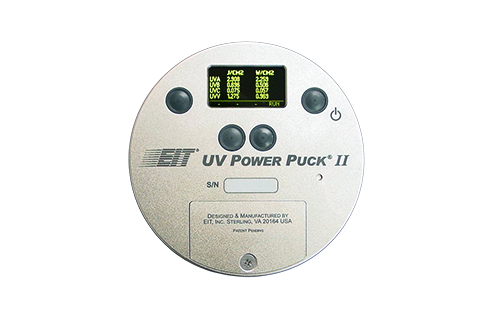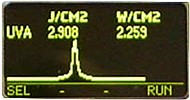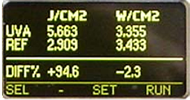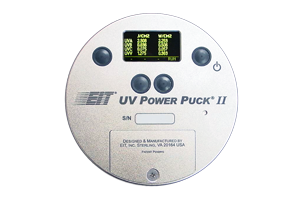Power Puck II UV Radiometer
Incorporates four separate spectral response ranges and measures all four simultaneously

The Power Puck II UV Radiometer first set the standard for the UV industry and is now setting a new standard with advanced features, a colorful, easy-to-read display, multiple user-selectable modes and PC communications for data logging and trending capabilities.
The Power Puck II UV Radiometer is widely used throughout the global UV industry. With user-selectable sample rates, this reliable instrument can be used for fast conveyor lines or slower lines. It:
- Incorporates four separate spectral response ranges and measures all four simultaneously
- Is used in UV curing applications of inks, adhesives, soldermasks and epoxies (not for use in web press applications)
- Display scrolls through UV dosage in J/cm2 and peak UV intensity in W/cm2 of all four separate UV spectral response ranges
- Measures lamp performance (and possible bandwidth shift for doped lamps)
- Compares the efficiencies of different UV curing systems
Easy to Use:
- Single button for on / off and run
- Data is simultaneously collected for up to four bands on the Power Puck II UV Radiometer, then displayed on a single screen in mW/cm2 and mJ/cm2 for quick and easy viewing by the operator.; no need to toggle through all eight readings, one screen at a time
- Soft buttons are used for function selections and are indicated on the bottom of the display for easy operator selection and use
- Select low, medium or high intensity for the graphical display brightness
- Unit of measure is user-selectable to provide ease of reading for operators. Selections are: mJ/cm2, mW/cm2, J/cm2, W/cm2, µJ/cm2, µW/cm2
- User-selectable instrument default modes for data analysis and comparison, screen and operational settings
- In graph mode, a graph illustrating the collected UV irradiance and energy is displayed for each of the UV bands. Data is expressed in mW/cm2 time
- Profiler versions include USB communications port to download collected data to a computer for statistical analysis and data logging; software provided by EIT
Bandwidths
- UVA (320–390nm)
- UVB (280–320nm)
- UVC (250–260nm)
- Visible (395–445nm)
Operating Ranges: The Power Puck II UV Radiometer instruments are now available in three operating or dynamic ranges. The standard (10W) unit works well for high-power UV curing applications. The new mid-range unit (1W) works well with lower power arc lamps and applications with lamps that are non-focused or a little further away from the cure surface. The low power unit (100 mW) works well in exposure systems and applications with low power lamps.

Instrument Sample Rate (Smooth) Functions
The Power Puck II oversamples at an extremely high rate. The user is able to adjust the effective sample rate used for data collection. For most applications, we recommend the Smooth Profiler setting.
- Smooth On: Effective sample rate of 25 Hz (samples per second), matches obsolete Power Puck units
- Smooth Profiler: Effective sample rate of 128 Hz, suggested rate for most applications. The Smooth Profiler setting reports the average (RMS) peak intensity.
- Smooth Off: Effective sample rate of 2048 Hz. Fast enough to detect the AC cycling in a 50/60 Hz power supply. Reports the instantaneous irradiance value which is higher than the RMS value.
Reference Mode: Used for comparison between readings. Can be useful for system setup and troubleshooting. The user can store the selected UV reading in the radiometer as a baseline or reference reading, then compare that reading to another. The UV radiometer will display both readings and indicate the percentage of change between readings. Data is displayed in mJ/cm2 and mW/cm2 and percentage.

Units will turn on and display data at irradiance values much lower than the suggested operating ranges. The suggested operating ranges are where the instrument performs best.
- High Power (Standard): UVA, UVB, Visible: 100mW/cm2–10W/cm2 / UVC: 10mW/cm2–1W/cm2
- Mid Power: UVA, UVB, Visible: 10mW/cm2–1W/cm2 / UVC: 1mW/cm2–100mW/cm2
- Low Power: UVA, UVB, Visible: 1mW/cm2–100mW/cm2 / UVC: 1mW/cm2–100mW/cm2
| Specifications | |
|---|---|
| Part # | UV1451 |
| Display | Easy to read, yellow text on black background |
| Accuracy | +/- 10%; +/- 5% typical |
| Spectral Ranges | 4-channel continuous monitoring. Standard version: 320–390nm (UVA), 280–320nm (UVB), 250–260nm (UVC), 395–445nm (Visible) |
| Spatial Response | Approximately cosine |
| Operating Temperature | 0–75°C internal temperature; tolerates high external temperatures for short periods (audible alarm indicates when temperature has exceeded tolerance) |
| Time-Out Period | 2 minutes DISPLAY mode (no key activity). A no time-out mode can be activated by EIT-IM. |
| Battery | Two user-replaceable AAA alkaline cells |
| Battery Life | Approx. 20 hours with display on |
| Dimensions (D x H) | 4.60 x 0.50"; 117 x 12.7 mm |
| Weight | 10.1 oz (289 grams) |
| Materials | Aluminum, stainless steel |
Carrying Case
| Carrying Case | |
|---|---|
| Material | Cut polyurethane interior, scuff resistant nylon exterior cover |
| Weight | 9 oz (260 grams) |
| Dimensions (W x H x D) | 10.75 x 3.5 x 7.75"; 274 x 89 x 197 mm |
Product Files
